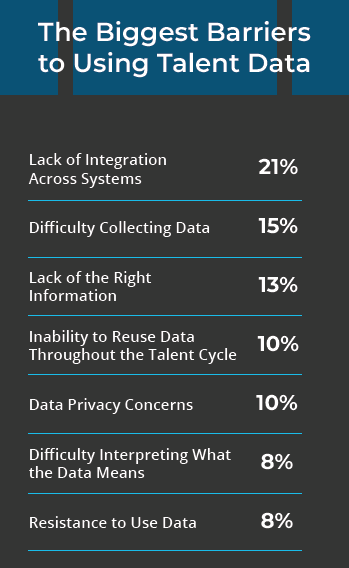Reshaping HR with Talent Analytics
How modern HR organizations are making talent data a critical part of their hiring and talent management by breaking down barriers to its use and leveraging talent analytics.
Share
An Overwhelming Abundance of Data
In a world where a whopping 329 million terabytes of data are created each day¹, organizations are sitting on a goldmine of information that can be used to improve their day-to-day operations. This data can allow organizations to gain insights into their customer base, develop a deeper understanding of the skills of their employees, and make better business decisions. With workforce potential and identifying and nurturing talent being of increasing importance, data can help target investment and development initiatives at those areas that are known to add value, or been identified to make the biggest impact.
According to a recent SHL global survey², 61% of organizations already rely on talent data to make business decisions, and over half of respondents (51%) expect the reliance on talent data to increase in the next 18 months.
Despite some progress, many organizations still struggle with effectively managing talent data through their HR systems, with nearly two-thirds of respondents unsatisfied with the ability of their current HR solution to meet the demands of the business. How can organizations leverage talent data and talent analytics to make more accurate decisions?
Reshaping HR with Talent Analytics
Firstly, it’s important to understand talent analytics. Talent analytics is the field concerned with the use of data and analytics to make better decisions about people. This data can come from many sources, including an organization’s internal HR (Human Resources) system, information about employee performance, employee surveys, customer feedback, and even assessments used during the hiring process. By taking a data-driven approach to HR, talent analytics provides organizations with the ability to understand their workforce, identify trends, and make predictions.
Nearly two-thirds of survey respondents are actively contemplating how to reshape HR strategies to effectively support evolving work dynamics—but simply opting for a general-purpose solution and expecting it to provide all the strategic insights for an organization might not be the most effective choice. Rather, organizations should consider their specific goals when it comes to leveraging talent data and determine which data sources are essential to achieve these objectives before selecting a talent analytics solution.
Overcoming Barriers to Using Talent Data
 With multiple data sources, there is a persistent challenge in integrating talent analytics data across systems. Organizations are aware of the importance of an integrated talent acquisition and talent management solution, citing lack of integration across systems as the biggest barrier to effective talent data use.
With multiple data sources, there is a persistent challenge in integrating talent analytics data across systems. Organizations are aware of the importance of an integrated talent acquisition and talent management solution, citing lack of integration across systems as the biggest barrier to effective talent data use.
It is not uncommon for separate systems to hold data about prospective and current employees but unless integrated well, this can increase the likelihood of erroneous data—creating data silos that are difficult to interrogate, interpret and use. Other barriers such as difficulty collecting data and the time taken to collect data also highlight issues that come from a lack of integration and easy-to-use data tools.
Through data reuse, business leaders will come to expect that they can gain insights into the state of their talent at any given time to help and improve the speed of their decision making, whether that be how teams would cope with a strategic change in direction, what the leadership pipeline looks like, or which skills are lacking within the organization.
HR teams will be expected to relay this information back easily through talent dashboards, reporting, or data models. Analytical and data skills will become an important part of an HR team’s armoury so they can fulfil these business requirements effectively.
What do data reuse, integration and talent analytics all have in common? The shift towards Data Democratization—making data easily accessible and understandable across the entire organization through simple tools and processes. For those businesses looking to improve their talent decision-making, a holistic approach to data and data tools to extract and use talent data at any frequency, time, and level is essential, and democratizing data will be key to success.
Check out our Global Talent Trends resources to see insights from our global survey to over 1,600 HR professionals about the latest trends in talent acquisition and talent management.
Find out more about how SHL helps organizations have a single source of talent data to effectively hire, manage, and develop talent.
¹https://explodingtopics.com/blog/data-generated-per-day
²The SHL Global Talent Trends report was conducted to over 1,600 Human Resources professionals working for national and international organizations of varied sizes (from 1 to 500,000 employees), across different industries, holding different responsibilities within their organizations (such as career development, diversity, equity, and inclusion, recruitment, and leadership development).









